
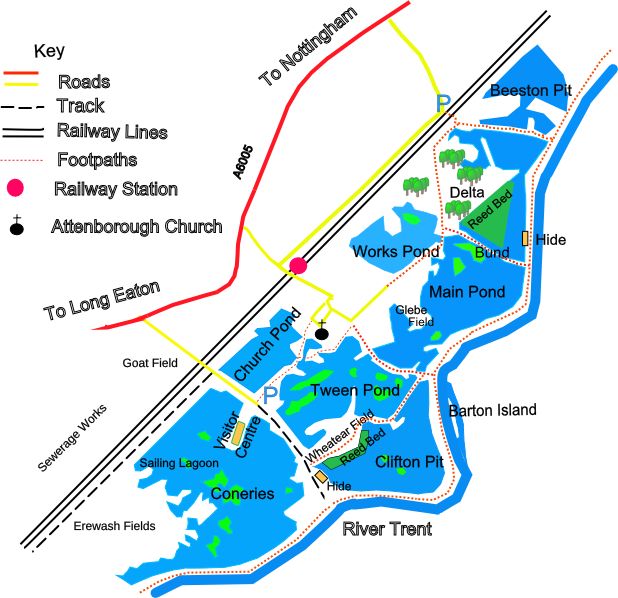
Access: Car parking is possible either at the visitor centre's large car park on Barton Lane off the A6005 at Chilwell (SK516339)–where a voluntary parking charge (£1.50) can be made or street parking on 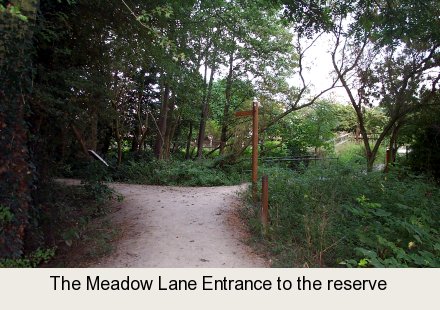 Meadow Lane (SK524354) with access over a railway foot crossing. The original car park which was accessed via Attenborough Village is now reserved for fishermen only. By train the reserve is 500m from Attenborough railway station. Most of the footpaths around the reserve are good, well made and flat and have been made suitable for the disabled with the help of grants.
Meadow Lane (SK524354) with access over a railway foot crossing. The original car park which was accessed via Attenborough Village is now reserved for fishermen only. By train the reserve is 500m from Attenborough railway station. Most of the footpaths around the reserve are good, well made and flat and have been made suitable for the disabled with the help of grants.
Facilities: Most of the Attenborough gravel pit complex which falls in Nottinghamshire is a Nottinghamshire Wildlife Trust reserve. The new NWT visitor centre, opened in the spring of 2005, provides refreshments, toilets and a Nottinghamshire Wildlife shop. There is a hide on the river Trent side of the delta area, keys for which can be purchased at the visitor centre shop. Most paths are suitable for the disabled–in fact a lot of money has been spent to bring the paths and one of the bridges up to standard. There are also several seats and benches around the western end of the NWT reserve.Several bird feeding tables are scattered around the reserve as well. Most of which are intended for the public to provide the food. Screens have been placed around the reserve in various spots. 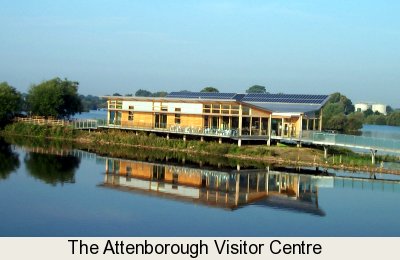
History: All of the gravel pits in the nature reserve area are worked out. Since the 1970s all of the gravel workings have been in Derbyshire. In 2004, however these have been stopped as well, but work now is going on at the Long Eaton end to restart gravel extraction in two areas. Because of the difficulty of getting large lorries through the narrow and busy roads of Long Eaton, barges will be seen again going along the barge channel to the aggregate works on Long Lane. In the 1970s the river Erewash was breached to allow the barges to travel between the works in Nottinghamshire and the gravel workings in Derbyshire. This lead to polluted water from the Erewash to enter the Attenborough Pits water system, degrading the water quality. To alleviate this, in 2009 the Erewash was embanked for much of its course through the coneries, with gaps to allow the barge traffic to pass through. Also a new reedbed has been created east of the Erewash.
Habitat: The Trent lies on the south-east border of the reserve, and the fields across the Trent (Barton Fields) can be worth a look at most times of the year. Also across the river are two flashes, the one opposite the Clifton Pit can be scanned easily, but the other one, across the river from the main pond is a lot more difficult to observe.
The so-called delta area was formed by sand washings, but this has stopped and the sand washings put into the Works pit, producing the area known as the "beach". An overgrown Osier bed covers much of the area known as the delta wood. A new hide overlooks this area, the code for the door keypad can be obtained from the visitor centre. The hide has space built into the roof for bats to roost in.
A lot of habitat improvement has been carried out by the Nottinghamshire Wildlife Trust in the past few years. This has consisted of clearing and thinning out some of the Willow, putting cattle in to graze the "L" field (opposite the Works Pit), to thin out the vegetation — Rabbits in this area are scarce — myxomatosis seems prevalent here. The biggest change has been at the western end of the reserve, with a new reedbed planted in Clifton Pit, two islands in Clifton Pit have been cleared of trees and partially flattened. 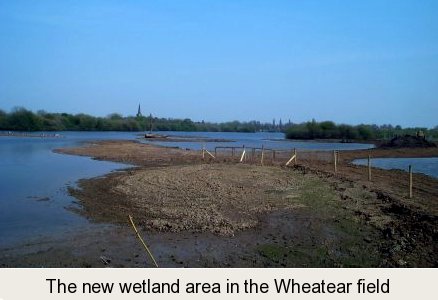 The Wheatear Field, has been levelled —the old spoil heaps have been pushed into Clifton pit to form the reedbed, and a new lagoon area developed on the north side of the field by Barton Ferry Lane.
The Wheatear Field, has been levelled —the old spoil heaps have been pushed into Clifton pit to form the reedbed, and a new lagoon area developed on the north side of the field by Barton Ferry Lane.
The Nottinghamshire Wildlife Trust have recently taken over the management of an old tip to the west of the coneries and the Erewash. This is the Erewash Fields. The area is now mainly soggy grassland with some bramble and birch scrub. This a favourite area for Grasshopper Warblers in the summer and Stonechats and perhaps Short eared Owls in the winter. A scrape has been excavated and a grazing enclosure built.
Birds: In early Winter large numbers of wildfowl such as Coot, Great crested Grebes, Teal, Tufted Duck and Pochard are present along with varying numbers of Goldeneye. There is a large Cormorant roost in the Coneries and good flocks of Goosander have appeared in the past few years on the Main and Works pits. Winter waders can include Snipe and Green Sandpiper depending on water levels. Large flocks (300+) of Lapwings and Black-headed Gulls can be found on the new lagoon area (Tween Pond) and on Clifton Pit. The Works Pit has been divided into two by the construction of a bund, with the eastern part having navigable water for the barges and the western part becoming silted up. There is a fair size corvid (a few hundred birds) roost in the winter months by the delta bund. These are mainly Jackdaws and Rooks, the Carrion Crows roost in the delta wood along with a few thousand Wood Pigeons. The Corvids largely come from the southwest (Barton, Thurgaton). Corvids from the north of Nottingham appear to use Wollaton Park as a roost site.
Green and Great Spotted Woodpeckers are common, but luck and persistence are needed for a Lesser Spotted Woodpeckers. The recommended spot to see these small elusive woodpeckers is from the North Path, which runs through the Delta wood. Observing the trees in the area around the metal gate entrance to the Delta Wood gives good views (eventually). Some years small flocks of Siskin can be seen feeding in the Alders, especially at the eastern end. 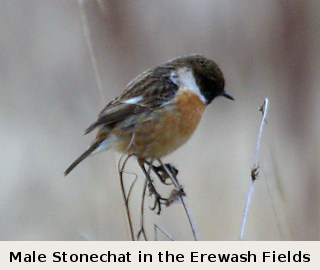 Gulls are almost entirely Black headed with the Tween Pond and Clifton Pit often used as "loafing" areas. Bitterns occur every winter and are best seen in the delta area, from either the hide or off the bund which runs North to South by the delta reedbed or else around the Clifton Pit reedbed. Low water levels help in seeing these birds and in the dry late autumn and early winter of 2003 were relatively easy to see, as were Water Rails. Frozen water causes them to wander more, because of the difficulty of finding food and possibly because of the threat of foxes wandering around on the ice. Stonechats are regular on the Erewash Fields area and upwards of two Chiffchaffs winter by the path which runs west to the Erewash Fields passing between the Coneries and the railway. These no doubt depend on the food at the nearby sewerage works.
Gulls are almost entirely Black headed with the Tween Pond and Clifton Pit often used as "loafing" areas. Bitterns occur every winter and are best seen in the delta area, from either the hide or off the bund which runs North to South by the delta reedbed or else around the Clifton Pit reedbed. Low water levels help in seeing these birds and in the dry late autumn and early winter of 2003 were relatively easy to see, as were Water Rails. Frozen water causes them to wander more, because of the difficulty of finding food and possibly because of the threat of foxes wandering around on the ice. Stonechats are regular on the Erewash Fields area and upwards of two Chiffchaffs winter by the path which runs west to the Erewash Fields passing between the Coneries and the railway. These no doubt depend on the food at the nearby sewerage works.
In Spring many migrants pass through the reserve with Whinchat and Wheatear being regular. The Wheatears are usually found across the river and the Whinchats either on the Wheatear field or the old tip area, which is across the river Erewash in Derbyshire. Nine species of warbler breed including Grasshopper Warbler — which is a regular over the county border, again in the old tip area, and good numbers of Lesser Whitethroat, Common Whitethroat and Garden Warbler. Black Terns can be seen, often with easterly winds and occasional flocks of Arctic Tern. Raptors such as Marsh Harrier and Osprey are virtually annual and always worth looking for in April. Waders can also be evident in spring with Little Ringed Plover, Common Sandpiper and Dunlin to be expected but with godwits and other scarce county waders possible.
Breeding birds include Great crested Grebes, Little Grebes, Common Terns, Black-headed Gulls, probably Sand Martins, Great spotted Woodpeckers, Song Thrushes, Cetti's Warbler, Reed and Sedge Warblers, Blackcaps, Garden Warblers, Common and Lesser Whitethroats, Chiffchaffs and Reed Buntings. There is a heronry about 1Km to the south in Barton Woods, although the Herons have suffered from harassment by Common Buzzards in recent years, forcing some of them to breed on islands in the reserve. In Late Summer hirundines and Swifts occur in good numbers on feeding sallies often attracting Hobbies. A regular feature of late summer is one or two adult Yellow legged Gulls which tend to favour either the Sailing Lagoon or the Works Pit. In fact Yellow legged Gulls are commoner here than Herring Gulls. The large numbers (40+ pairs) of Common Tern breed on specially constructed platforms on Main, Church and Beeston Ponds. Black-headed Gulls have also bred here for the past few years on one of the flattened islands on Clifton Pit
In Autumn wader migration is more varied as water levels are usually lower than in spring, exposing more mud and generally the waders take their time as they migrate south, rather than the mad rush to breed in the north. The new lagoon area on Tween Pond, Clifton Pit, the Works Pit and, if it has been a dry summer, the Wet Marsh will all hold waders. Garganey perhaps lingering in the delta lagoons or Clifton Pit. Autumn is also the time for rarities with anything possible. Hobbies become more noticeable as they hawk dragonflies
Rarities: Attenborough has many rarities to its credit including Nationally rare birds such as Penduline Tit (1994), Squacco Heron (1998 & 2011), Purple Heron (2003), Sora (2004) and White-winged Black Tern (2013). Some of the county rarities seen are Great White Egret (2013), Bearded Tit, Spotted Crake (1995 & 2007) and Green-winged Teal (1996). There is a least one Bittern present every winter.
General Information:
The reserve recorder is
Mr P Sadler, 197 Cator Lane North, Chilwell, Nottingham, NG9 4BLThe reserve itself is managed by the Nottinghamshire Wildlife Trust and most of the land is owned by Cemex.
Any criticisms, corrections or comments to the author Derek Huskisson

The text and photographs are licensed under a Creative Commons Attribution-Noncommercial-Share Alike 2.0 UK: England & Wales License.